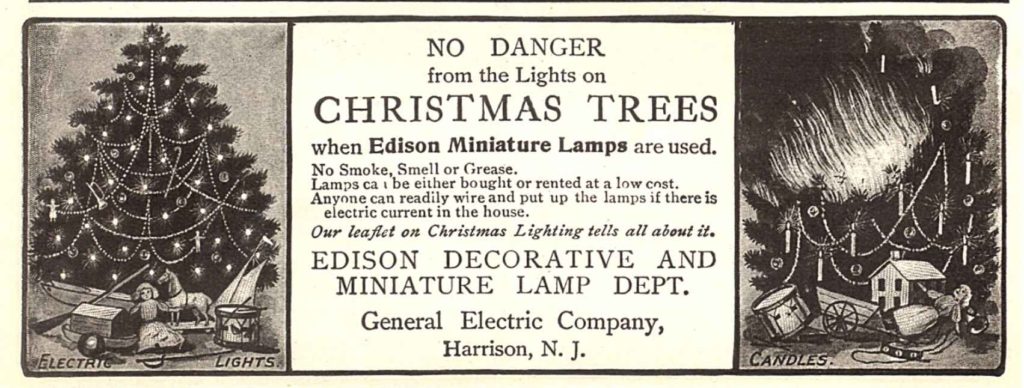Hope deferred makes the heart sick, but a longing fulfilled is a tree of life.
Proverbs 13:12
String of mostly-working lights in place? Check.
Roughly perpendicular to the floor? Check.
Toy train, rapidly consuming AA batteries, circling the base? Check.
My Christmas tree is set up for the season. A few presents have already been placed beneath. My Tannenbaum is locked in.
But why? Where did the tradition of the Christmas tree come from, anyway?
Settle in, because the story’s pretty interesting.
Most historians agree that the winter tradition of bringing evergreens into one’s home predates Jesus. For centuries BCE, ancient peoples – especially those living in southern Europe and Italy – adorned their homes with fir, pine, and spruce branches as reminders of the warmer times of the year. Decorating their windows and mantels with green evidently cheered them up when the outdoors was all brown and white.
While it’s likely that some of these practices were connected with ancient pagan traditions, by the Middle Ages, Christian missionaries in Europe had declared these symbols to be under the Lordship of Jesus. On one famous occasion, the Eighth Century missionary Boniface hewed down an oak tree sacred to the Norse god Thor, redirecting attention to a fir tree whose greenness Boniface considered symbolic of God’s mercy. A later legend suggested that at the birth of Christ, every tree around the world miraculously shook off its snow and produced new green shoots.
But what about the tradition of decorating of the Christmas tree? Here’s where the Bible story weaves in.
Many scholars think that the practice gained popularity in Renaissance times and afterward. Expanding on older traditions, Europeans began hanging apples and nuts from their “Paradise Trees” as reminders of the Garden of Eden.
It’s a widely-held belief that Martin Luther was the first to add lights to the Christmas tree. According to the story, the great Reformer was walking about one evening when he was awed by the brilliance of stars twinkling amidst the pines. To recreate the scene for his family, he erected a tree in the main room and adorned its branches with lighted candles.
By the 1650’s, people in Germany had made tree-lighting a tradition. Folks would clip (or melt!) small candles directly onto the branches of the tree and light them for a few minutes each evening. This provided German homes a warm gauzy glow; it also opened the door to potential yuletide infernos. This is not the sort of holiday tradition that Smoky the Bear would have approved.
Safer Christmas celebrations arrived with the invention of electric lighting in the 19th Century. By 1879 Thomas Edison had perfected the light bulb in his Menlo Park lab, and within 3 years his friend Edward Johnson had developed the first strand of Christmas lights. By 1900, department stores started using the new wired bulbs for their Christmas displays, and in 1908 insurance companies announced that they would no longer cover house fires resulting from toasted-out Tannenbaums. (It was around that time that lab-tested, cutting-edge scientific research revealed that clipping live fire onto your dead and drying tree could possibly present a safety hazard).
That’s a point that wasn’t lost on retailers. Check out the newspaper ad below: on the left is the tree with its newfangled electric decorations. On the right is what happens when you don’t use Edison bulbs. It’s a full-on bonfire in your drawing room. But you know, the choice is yours.
This is your tree, this is your tree on candles. Any questions?

Across the centuries, the decorating of the annual Christmas tree has presented Christian families with a teachable moment. Because the story of the Bible – and the story of salvation, with its great high point at Christmas – cannot fully be told without reference to trees.
It’s like this: We can’t understand salvation unless we understand sin, and we can’t understand the origin of sin without talking about the Tree of the Knowledge of Good and Evil. Genesis 3. Because of their disobedience at that First Tree, Adam and Eve were banned from the other named tree in the Garden, the Tree of Life.
Trees appear significantly in the words of the prophets, too. Micah describes life in God’s perfect world as one in which the head of each family sits under his own fig tree (Micah 4:4). In Hosea 14:8, God describes himself as like a juniper that makes the nation fruitful.
But it’s in the Jesus story that the theological applications of the tree are clearest.
When I was in seminary, I spent a lot of time studying a religious historian named Mircea Eliade. Eliade, a brilliant reckoner of symbolism, identified trees as axial. They represent connecting-places where God meets man. That which is above unites with what is below.
This is what is happening at Christmas. Jesus, he who is 100% of Heaven, was incarnate and became as one of Earth. He was fully divine and fully man, eternally the Son of God and entirely the child of Mary.
For thirty years, Jesus dwelt with his brothers and sisters in the long, dismal shadow of the First Tree. Though he had committed no sin, the God-Man carried the full weight of the people’s iniquity.
Then he bore it away to the Second Tree, to the cruel spike that stood in the middle of Mount Calvary. That tree was stained red with the blood of a Galilean and coal-black with the guilt of all of humanity. Raised by a condemning world below and rejected by a righteous Father above, Jesus died as one forsaken by both. The One who was perfectly of heaven and the greatest of mankind could not be accepted by either.
But something amazing happened at Calvary’s Tree. Galatians 3:13 says that because he hung on this Second Tree, Christ redeemed us from the curse of the First. George Herbert’s Sacrifice lands these lines on the lips of Jesus:
O all ye who pass by, behold and see:
Man stole the fruit, but I must climb the tree;
The tree of life to all, but only me:
Was ever grief like mine?
Lo, here I hang, charged with a world of sin,
The greater world o’ the two; for that came in
By words, but this by sorrow I must win.
Because Jesus has accepted the cross of Calvary, we can confidently approach the Final Tree. The Tree of Life, forfeit in the Garden of Eden, is accessible once more. Revelation 22 says that this Perfect Tree, fruitful in every season, stands astride a river of crystal and extends healing to all the nations. Through this Tree, God will salve all of our wounds, refresh our wandering and lonely hearts with love, repair governments and societies, and undo our cancers and afflictions.
The Christmas tree, ever-green, points heavenward like an arrow, reminding us this Christmas that Life-Without-Autumn, a Forever-Without-Winter, awaits those who look to Calvary for their greatest gift.


